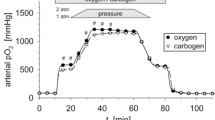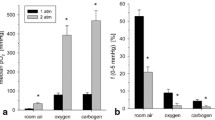Abstract
Purpose
The lower OER of high-LET radiations, compared to conventional (low-LET) radiations, has often been put forward as an argument for using high-LET radiotherapy in the management of hypoxic tumours. Among the different neutron beams used in therapy, the reactor fission neutrons have the lowest OER. The aim of the present study is to follow the variations of tumour oxygenation status during fractionated irradiation with different radiation qualities. Little information is available so far after fractionated high-LET irradiation. In addition, the RBE of reactor fission neutrons for effects on tumours and on normal tissues are compared.
Material and Methods
Murine OTS 64-osteosarcomas were transplanted in 102 balb-C mice and irradiated by 36 Gy of photons in fractions of 3 Gy five times a week (group P-36/3) or by 12 Gy of reactor fission neutrons in fractions of 2 Gy two times a week (group N-12/2). Irradiations started at a tumor volume of 500 to 600 mm3. A third group received no radiotherapy, but all investigations (group CG). Tumor volume and tumor oxygenation were measured once a week under therapy and during three weeks after therapy. For in vivo-evaluation of oxygen status a computerized polarographic needle electrode system (KIMOC pO2 histograph, Eppendorf) was used. The median pO2 and the hypoxic fraction (pO2 values <5 mm Hg) of single tumors and of total groups were calculated from pooled histograms and from row data as well.
Results
In correlation with the increase of tumor volume, from day 1 to day 42 of follow-up the median pO2 decreased from 20 mm to 8 mm Hg and the hypoxic fraction increased from 7% to 31%. After fractionated photon therapy a growth delay of three weeks was observed. Six weeks after beginning of the irradiation the median tumor volume had been doubled again. After fission neutron therapy growth delay continued until the end of the follow-up period. In both of the irradiated groups a significant decrease of median pO2 values and an increase of the hypoxic fraction were observed under radiotherapy. Hypoxia was more intensive after neutrons with a decrease of the median pO2 from 20 mm Hg to 1 mm Hg vs. 10 mm Hg after photon therapy and with an increase of the hypoxic fraction from 7% to 78% vs. 36% respectively. Two weeks after the end of therapy the median pO2 and the hypoxic fraction of both treated groups reached the levels prior to irradiation indicating a complete reoxygenation.
Conclusion
During fractionated irradiation of murine osteosarcomas weith photons and reactor fission neutrons, a marked hypoxia was observed for both radiation qualities, but hypoxia was more intense during fractionated neutron irradiation. After irradiation, a complete reoxygenation occured in both groups independently of the degree of hypoxia observed during the treatment. The RBE of reactor fission neutrons, after fractionated irradiation, was much higher for effects on murine osteosarcomas compared to their RBE observed for normal tissues in previous experiments. Present data are in agreement with our clinical observations on more than 300 patients treated with reactor fission neutrons for advanced and hypoxic tumours with various histologies.
Similar content being viewed by others
References
Afzal SMJ, Tenforde TS, Kavenau KS, et al. Reoxygenation in a rat rhabdomyosarcoma tumor following x-irradiation. Int J Radiat Oncol Biol Phys 1991;20:473–7.
Auberger T, Weissfloch L, Senekowitsch R, et al. Oxygen Tensions in isotransplanted mammary carcinomas and osteosarcomas before and after irradiation. In: Vaupel PW. Tumor oxygenation. Fischer. 1995: 153–64.
Auberger T, Reuschel W. The Role of Fast Neutrons in the Treament of Squamous Cell Carcinomas of Head and Neck: The European Experience. In: Engenhart-Cabillic R. Wambersie A. Fast Neutrons and High-LET Particles in Cancer Therapy. Springer, 1998; 137–47.
Auberger T, Reuschel W. Reactor fission neutron therapy in recurrent mammary carcinoma. In Kogelnik HD (ed.). Progress in radiooncology. Bologna: Monduzzi, 1997.
Barendsen GW, Walter HMD, Fowler JF, et al. Effects of different ionizing radiations on human cells in tissue culture. III. Experiments with cyclotron-accelerated alpha-particles and deuterons. Radiation Research 1963;18:106–19.
Barendsen GW. Responses of cultered cells, tumors and normal tissues to radiation of different linear energy transfer. In: Ebert M, Howard A (ed.). Current topics in radiation research. Amsterdam: North-Holland Publ, 1968;4:293–357.
Breiter N, Kneschaurek P, Burger G, et al. RBE of fast fission neutrons (2 MeV) for chronic radiation damage of the large bowel of rats after single dose and fractionated irradiation. Int J Radiat Biol 1986;49:1031–8
Breteau N, Demasure M, Lescrainier J, et al. Sacrococcygeal Condromas: Potential Role of High-LET Therapy. In: Engenhart-Cabillic R, Wambersie A. Fast Neutrons and High-LET Particles in Cancer Therapy. Springer, 1998.
Boucher Y, Baxter LT, Jain RK. Interstitial pressure gradiants in tissueisolated and subcutaneous tumors: implications for therapy. Cancer Res 1990;50:4478–84.
Curtis SB. Survival of oxygenated and hypoxic tumour cells in the extended-peak regions of heavy charged-particle beams. Radiation Research 1982;90:292–309.
Griffin TW, Pajak TF, Maor MH, et al. Mixed neutron/photon irradiation of unresectable squamous cell carcinoma of the head and neck: the final report of a randomized cooperative trial. Int J Radiat Oncol Biol Phys 1989;17:959–65.
Gueulette J, Menzel HG, Pihet P, et al. Specification of Radiation Quality in Fast Neutron Therapy: Microdosimetric and Radiobiological Approach. In: Engenhart-Cabillic R, Wambersie A. Fast Neutrons and High-LET Particles in Cancer Therapy. Springer, 1998;31–53.
Hall EJ, Kellerer AM, Friede H. Dependence of neutron energy of the OER and RBE. Int J Radiat Oncol Biol Phys 1982;8:1567–72.
Horsman MR, Khalil A, Nordsmark M, et al. The use of oxygen electrodes to predict radiobiological hypoxia in tumors. In: Vaupel PW, Kelleher DK, Günderoth M. Tumor Oxygenation. Fischer, 1995.
Kallinowski F, Schlenger KH, Kloes M, et al. Tumor blood flow: the principal modulator of oxidative and glycolytic metabolism, and of the metabolic micromilieu of human tumor xenografts in vivo. Int J Cancer 1989; 44:266–72.
Kallman RF, Dorie MJ. Tumor oxygenation and reoxygenation during radiation therapy: their importance in predicting tumor reponse. Int J Radiat Oncol Biol Phys 1986;12:681–5.
Kelleher DK, Thews O, Vaupel P. Can Erythropoietin improve tumor oxygenation? Strahlenther Onkol 1998;174(Suppl IV):20–3.
Kitakabu Y, Shibamoto Y, Sasai K, et al. Variations of the hypoxic fraction in the SCC VII tumors after single dose and during fractionated radiation therapy: assessment without anesthesia or physical restraint of mice. Int J Radiat Oncol Biol Phys 1991;20:709–14.
Köster L. Applicability of reactor fission neutrons for radiation therapy of cancer. Nucl Science Appl 1984;2:79–96.
Koutcher JA, Alfieri AA, Devitt ML, et al. Quantitative changes in tumor metabolism, partial pressure of oxygen, and radiobiological oxygenation status postradiation. Cancer Res 1992;52:4620–7.
Kummermehr J, Schraube H, Ries G, et al. Biological effectiveness of neutrons and pi-mesons in gut, bone, and transplantable tumours. Strahlenther Onkol 1989;165:276–82.
Lavey RS. Clinical trial experience using erythropoietin during radiation therapy. Strahlenther Onkol 1998;174(Suppl IV):24–30.
Molls M, Stadler P, Becker A, et al. Relevance of oxygen in radiation oncology. Strahlenther Onkol 1998;174(Suppl IV):13–6.
Molls M, Feldmann HJ, Stadler P, et al. Changes in tumor oxygenation during radiation therapy. In: Molls M, Vaupel P (eds.), Blood perfusion and microenvironment of human tumors. Berlin-Heidelberg: Springer, 1997;81–7.
Rofstad EK. Hypoxia and reoxygenation in human melanoma xenografts. Int J Radiat Oncol Biol Phys 1989;17:81–9.
Schwarz R, Krüll A, Lessel A, et al. European Results of Neutron Therapy in Soft Tissue Sarcomas. In: Engenhart-Cabillic R. Wambersie A. Fast Neutrons and High-LET Particles in Cancer Therapy. Springer, 1998; 100–12.
Stadler P, Auberger T, Feldmann HJ, et al. Changes in tumor oxygenation after fractionated radiotherapy with neutrons. In: Kogelnik HD (ed.): Progress in radiooncology VI. Bologna: Monduzzi, 1998;727–31.
Thews O, Kelleher DK, Vaupel PW. pO2-mapping of experimental rat tumors: visualisation and statistical analysis. In: Vaupel PW. Kelleher DK, Günderoth M. Tumor Oxygenation. Fischer, 1995;27–38.
Thews O, Kelleher DK, Vaupel PW. Intra- and inter-tumor variability of oxygenation: quantification and evaluation of minimum number of electrode tracks for representative measurements. In: Vaupel PW, Kelleher DK, Günderoth M. Tumor Oxygenation. Fischer, 1995;39–48.
Vaupel P, Frinak S, O’Hara M. Direct measurement of reoxygenation in malignant mammary tumors after a single large dose of irradiation. Adv Exp Med Biol 1984;180:773–82.
Vaupel P, Kallinowski F, Okunieff P. Blood flow, oxygen and nutrient supply, and metabolic microenvironment of human tumours: a review. Cancer Res 1989;49:6449–65.
Vaupel P, Schlenger K, Höckel M. Blood flow oxygenation of human tumors. In: Vaupel P, Jain RK. Tumor blood supply and metabolic microenvironment. Fischer, 1991;165–85.
Vaupel P. Effects of physiological parameters on tissue response to hyperthermia: new experimental facts and their relevance to clinical problems. In: Gerner EW, Cetas TC. Hyperthermic oncology 1992. Arizona board of regents. 1993;17–23.
Vynckier S, Schmidt R. The Physical Basis for Radiotherapy with Neustrons. In: Engenhart-Cabillic R, Wambersie A. Fast Neutrons and High-LET Particles in Cancer Therapy. Springer, 1998;1–30.
Wambersie A. Fast neutron therapy at the end of 1988 — a survey of the clinical data. Strahlenther Onkol 1990;166:52–60.
Zywietz F. Vascular and cellular damage in a murine fractionated treatment with radiation and hyperthermia. Strahlenther Onkol 1990;166:493–501.
Zywietz F, Reeker W, Kochs E. Tumor oxygenation in a transplanted rat rhabdomyosarcoma during fractionated irradiation. Int J Rad Onc Biol Phys 1995;32:1391–1400.
Author information
Authors and Affiliations
Corresponding author
Rights and permissions
About this article
Cite this article
Auberger, T., Thürriegl, B., Freude, T. et al. Oxygen tension in transplanted mouse osteosarcomas during fractionated high-LET-and Low-LET radiotherapy — Predictive aspects for choosing beam quality?. Strahlenther Onkol 175 (Suppl 2), 52–56 (1999). https://doi.org/10.1007/BF03038889
Issue Date:
DOI: https://doi.org/10.1007/BF03038889




